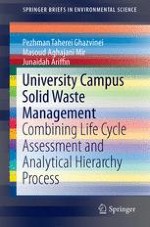This volume provides a comprehensive method for optimizing solid waste management practices and procedures at college and university campuses through the use of cluster analysis to combine Life Cycle Assessment and Analytical Hierarchy Process. Author Pezhman Taherei uses Malaysia’s University of Malaya as a case study and model, and through this method was able to assess which combination of waste disposal, management, and recycling techniques generate the least environmental impact while retaining the maximum cost savings for the university. A method for analysis of solid waste composition is also proposed.
Higher education institutes generate thousands of tons of solid waste per year. Comprehensive solid waste management programs, which take integrated solid waste management systems into consideration, are one of the greatest challenges to achieving campus sustainability. This system can serve as a guide and blueprint for other universities that are taking steps toward sustainability through improved solid waste management.
